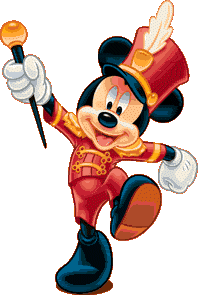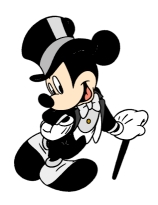

I'll keep this short, since we're going to be having reports on the various sections in class, but there are a few things I'd like you to be sure to focus on in this treatment of the arrival and early years of Walt Disney in Hollywood. (If you have time, you might skim the earlier chapters which deal with Disney's early life and career; it's easy reading and you may find Schickel's backgrounding of this major animation figure useful.)
Chapter 4 opens with an overview of Hollywood and the movie industry in 1923, the year Disney arrived there. As you read, you should note particularly the transition from content that was shocking and uncensored to a belief that the movie industry needed to be reined in and regulated, lest it corrupt the morals of middle America ("the fly-overs," to movie moguls). How did Disney fit into the trends in the industry in the mid-twenties?
The next section, on the history of animation, should fill in and review some of your other reading. Note particularly when and how the conventions of the animated cartoon were established--and note also what technologies were missing and therefore problematic for a graphic medium.
The third section in Chapter 4 details the rise of Walt and Roy Disney, and you should pay special attention to the steps by which they were able to move from a two-man operation, producing fairly basic product, to a small studio able to command $2,250 per cartoon.
Chapter 5, "Bringing Forth the Mouse," details the conception and birth of Mickey Mouse, following him into his early years in the sound era. Notice how many different accounts there are of who exactly designed and drew Mickey. Beyond that, you should pay particular attention to the description of how he should be drawn on p. 117. What is the advantage of this kind of design in an industry becoming increasingly aware of the relevance of the words of Frederick W. Taylor (Principles of Scientific Management; 1911): Good management is "knowing exactly what you want men to do, and then seeing that they do it in the best and cheapest way"? How does the Disney studio described in this chapter begin to apply this principle of mass production?
 The
difficulties Disney encountered in making Mickey Mouse speak in exactly the
way he intended him to are important clues to Disney's genius for controlling
his market; note the description on pp. 131-132 as one explanation for why the
sound cartoons caught on so immediately with the mass audience of the time.
Finally, Schickel describes The Skeleton Dance, the first of the Silly
Symphonies (and one we watched in class) in this chapter. As we move into
a closer examination of the Disney cartoons of the 1930s, keep in mind Schickel's
explanation of what the Symphonies series meant to Disney: "What
it did was add another string to his bow, forming the basis for a series of
films in which, free of the artistice conventions and story lines imposed on
him by Mickey and his 'gang,' he could experiment with techniques."
The
difficulties Disney encountered in making Mickey Mouse speak in exactly the
way he intended him to are important clues to Disney's genius for controlling
his market; note the description on pp. 131-132 as one explanation for why the
sound cartoons caught on so immediately with the mass audience of the time.
Finally, Schickel describes The Skeleton Dance, the first of the Silly
Symphonies (and one we watched in class) in this chapter. As we move into
a closer examination of the Disney cartoons of the 1930s, keep in mind Schickel's
explanation of what the Symphonies series meant to Disney: "What
it did was add another string to his bow, forming the basis for a series of
films in which, free of the artistice conventions and story lines imposed on
him by Mickey and his 'gang,' he could experiment with techniques."
In class, we'll be taking a look at some highlight of Mickey's career, with an emphasis on the way in which he was developed as a character at the same time he was becoming a corporate symbol. Time permitting, we'll look at the following cartoons: